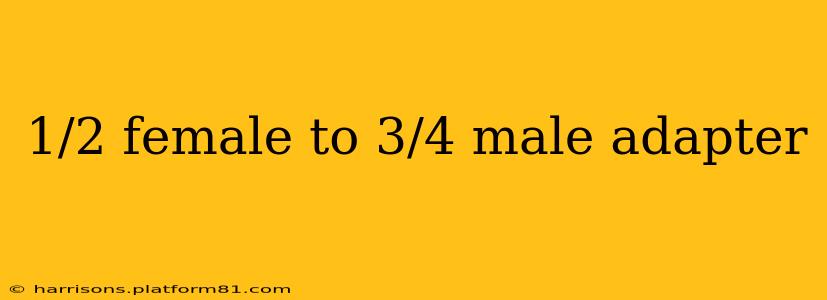Finding the right adapter for your plumbing or other applications can be tricky. This guide focuses specifically on the common need for a 1/2" female to 3/4" male adapter, explaining its uses, types, and how to choose the best one for your project.
What is a 1/2" Female to 3/4" Male Adapter?
A 1/2" female to 3/4" male adapter is a plumbing fitting used to connect pipes or fixtures with different sizes. The "female" end has internal threads (where a pipe with external threads screws into), measuring 1/2 inch in diameter. The "male" end has external threads (that screw into a fitting with internal threads), measuring 3/4 inch in diameter. This allows you to bridge the gap between plumbing components with incompatible sizes.
What are the Common Uses of a 1/2" Female to 3/4" Male Adapter?
This type of adapter is versatile and has applications in various contexts:
- Plumbing: The most common use is connecting 1/2-inch supply lines to 3/4-inch fixtures, such as faucets, washing machines, or toilets. It's particularly useful during renovations or repairs where existing plumbing doesn't match new fixtures.
- Irrigation: In sprinkler systems or drip irrigation setups, adapters might be needed to link different sized pipes or valves.
- Industrial Applications: These adapters can be employed in industrial settings where fluid transfer between different sized components is required.
- Compressed Air Systems: Some compressed air systems use these adapters to connect components of different diameters.
What Types of 1/2" Female to 3/4" Male Adapters Exist?
Several materials and styles are available, each with its advantages and disadvantages:
- Brass: Brass adapters are durable, corrosion-resistant, and ideal for most plumbing applications. They tend to be more expensive than plastic but offer superior longevity.
- Plastic (PVC, CPVC): Plastic adapters are lightweight, less expensive, and suitable for less demanding applications. They are not as durable as brass and may not be appropriate for high-pressure situations or with certain chemicals.
- Galvanized Steel: Galvanized steel adapters provide excellent strength and durability but are prone to corrosion over time.
Choosing the Right Material: What Material Should I Use?
The best material depends on your specific application. For most home plumbing projects, brass offers a good balance of durability and cost-effectiveness. For low-pressure systems where cost is a primary factor, plastic might suffice. For applications involving aggressive chemicals or high temperatures, consult a plumbing professional to determine the most suitable material.
Where Can I Find a 1/2" Female to 3/4" Male Adapter?
These adapters are readily available at various retailers:
- Home Improvement Stores: Major home improvement chains like Home Depot, Lowe's, and Menards usually stock a wide variety of plumbing fittings.
- Plumbing Supply Stores: Specialized plumbing supply stores often have a broader selection and may offer advice on choosing the right adapter.
- Online Retailers: Online marketplaces like Amazon and eBay offer a convenient way to purchase adapters, often at competitive prices.
How Do I Install a 1/2" Female to 3/4" Male Adapter?
Installation is typically straightforward:
- Turn off the water supply: This prevents leaks and water damage during installation.
- Clean the threads: Use a pipe thread cleaner to remove any debris or old sealant from the threads of both the adapter and the pipes.
- Apply pipe sealant (Teflon tape): Wrap Teflon tape around the male threads of the adapter (3-4 wraps).
- Screw the adapter onto the 1/2" female pipe: Tighten securely using a wrench or pliers.
- Connect the 3/4" male pipe to the adapter: Tighten securely.
- Turn the water supply back on: Check for leaks.
What Size Wrench Do I Need for a 1/2" Female to 3/4" Male Adapter?
The wrench size will depend on the adapter's nut size. Generally, you'll need an appropriately sized adjustable wrench or possibly two wrenches (one for each side to prevent twisting) — 1/2" and 3/4" wrenches will likely be needed depending on the pipe materials and the specific adapter design.
What if the Adapter Leaks?
A leaking adapter can be frustrating. If a leak occurs, check the following:
- Proper thread sealing: Ensure the Teflon tape was applied correctly and that the adapter is tightly secured.
- Damaged threads: If the threads are damaged, you’ll need to replace the adapter.
- Incorrect adapter type: Make absolutely sure you are using the correct 1/2" female to 3/4" male adapter.
This comprehensive guide should equip you with the knowledge to select and install the right 1/2" female to 3/4" male adapter for your specific needs. Remember to always prioritize safety and consult a professional plumber if you are unsure about any aspect of the installation process.
